
Use the regular VStack when you have a small number of subviews or don’t want the delayed rendering behavior of the lazy version.
Swiftui vstack alignment how to#
That’s a lot, and since the whole community is already creating plenty of SwiftUI content, even writing books, I want to focus on a practical example of how to replicate a Tinder-like UI using this lovely framework. Unlike Lazy VStack, which only renders the views when your app needs to display them, a VStack renders the views all at once, regardless of whether they are on- or offscreen.
Swiftui vstack alignment code#
SwiftUI replaces AutoLayout - everything is based on stack views now 'SwiftUI by Example/View layout' 16 Position it at the bottom of the ImageView Make sure you've selected SwiftUI as the interface mode and create a new project Don't expect to be able to take a beautiful SwiftUI application for iOS, drop the code into a SwiftWebUI project and get it to render exactly.
Swiftui vstack alignment series#
SwiftUI is not based on Storyboards! Hello, code review 🙂 Apple Documentation From SwiftUI beta 3 forward, you can center a text view with the. In this part of the SwiftUI Layout System series I will cover everything you need to.This is a perfect case for overriding an alignment guide. We can face the problem when image has some spacing inside a bitmap, and it looks not aligned very well. Position the image within a custom frame: Image ( 'fall-leaves' ). For example, we might need to align the bottom of Image and Text views in a horizontal stack. SwiftUI Image with text header aligned to top of the screen.In UIKit, we have to manually create a background view and make sure it sits at the back. SwiftUI is not just a wrapper for UIKit - it’s new and built using Swift! SwiftUI allows us to override standard alignments by using the alignmentGuide modifier. It can be anything such as color, image, or another view.SwiftUI is compatible with all Apple platforms.And it repositions all but the largest view in your stack, so they’re lined up on the leading edge. This tutorial is part of my SwiftUI Tutorial series.

ScrollView can be scrolled horizontally, vertically, or both. It will also place some adjustments in order to avoid safe areas. The view automatically adjust its size to fit the placed objects inside. That inserts the alignment argument into your VStack’s initializer. The ScrollView of SwiftUI allows efficient creation of scrolling containers. Mac, iOS, iPad, WatchOS and tvOS developers are hyped! Now, open the inspector for the VStack, by option-control-clicking to either side of the text or pancakes and click on the button next to Alignment. Firstly we are using GeometryReader, this will allow us to get the size and position of our parent view, we will only be using the width. In MetroBuddy, I created a reusable view component that automatically switches the axis of the stack based on the isAccessibilit圜ategory property of the size category.Did you hear about the new UI Framework Apple announced at WWDC 2019? It’s called SwiftUI and it feels like magic. There are two major changes in the above code compared to Solution 1. One solution to this problem is accessing the sizeCategory property of your view's environment to determine whether to use an HStack or a VStack. You would typically use an HStack for this.īut when a user increases their font size using Dynamic Type, you would end up with the following layout, which is not very intelligible: The following layout is very common: it is a row in a list that shows a text on the left and a button on the right. I also need to have messages aligned to the bottom. In SwiftUI, this functionality is provided by HStack and VStack. Currently building a chat application and I need new messages to appear at the bottom of the screen. Since iOS 9 and the introduction of UIStackView, stacks have become a common building block on iOS.



Published on SeptemByte of the Week: Accessible Stack Axis in SwiftUI


 0 kommentar(er)
0 kommentar(er)
